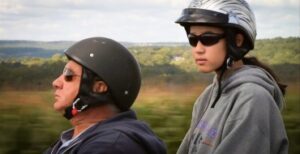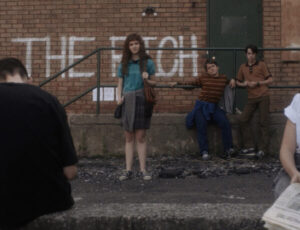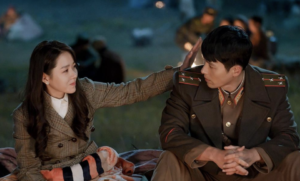The We and the I is an incandescent doodle of a movie, a messy scrawl that’s nonetheless beautiful for its energetic, unapologetic habitation of a moment and an idea. The moment is the last day before summer holidays at a South Bronx high school. The idea, as the title indicates, is the breakdown of the human pack, represented here by a large group of high school students who share a bus route. Gondry uses his cast of teens to explore the conflicting personas of individuals in and out of their social groups, turning a bus carrying them home from their last day of classes into a hotbed of young identities in flux.
The film recognizes life as one big role-play, and throws a bunch of teens–amateurs at life, as it were–into that larger, omnipresent role-playing class that is adolescence. Conceived with the help of Bronx after-school program The Point, Gondry’s low-budget project, with its cast of unknowns, might seem like an experimental appetizer whipped up before his upcoming higher-profile, more recognizably auteurist release Mood Indigo (starring Audrey Tatou). But it shouldn’t be dismissed as such. The We and the I might just be Gondry’s best film in nearly a decade. Despite the signature touches of low-budget, hand-crafted visual trickery in flashbacks and fantasy inserts, the film’s quite unlike anything Michel Gondry’s done before, because the director boldly hands it to the teenagers that populate it. Not to belittle Gondry’s sometimes overly twee cinematic magic realism (Eternal Sunshine of the Spotless Mind remains one of the finest films of the ‘00s), but the emphasis on improvisation, as well as the cast of actual South Bronx teenagers, lends this film an authenticity, a weighted verisimilitude that feels different from his dreamier fictions. But the poetry of dream remains in Gondry’s lovely, patient observance of these developing souls at play from noon to summer twilight. The French director might not have been familiar with the Bronx when he took on this project, but you can’t tell from the end result. Even as it unfolds it becomes a quintessential New York City movie, by virtue of being about real people who live in the city. The diversity of the mostly non-white cast makes for a welcome shift in perspective from most American movies about teenagers. Similarly, the film’s portrayal of two gay couples is refreshingly frank, showing them as no more or less complicated than the others on the bus. As the MTA bus roams through late afternoon and into sunset, we see the teenagers, buzzed on the temporary liberation of summer, sum up their school year in a frenzy of chaotic interaction that runs the gamut from tomfoolery to tragedy. Our anchors are Teresa (Terasa Lynn), a quiet but sociable artist, and Michael (Michael Brodie), a member of the rowdy back-of-the-bus boys’ club. The two share a troubled friendship muddied by their divided social loyalties. But as a semester’s worth of interpersonal dramas reach a petty singularity in the bus, it becomes clear that the entire teenage ensemble is the character here. Gondry portrays them as an amorphous organism painfully separating into individual entities for the summer, as if in preparation for the relative solitude of adulthood. It’s fascinating, and sometimes painful, to watch, perfectly capturing the enchanted cruelty of the teenage years. Gondry and his cast give us an unabashed look at growing humanity–the extroverted confidence of alpha teens (boys and girls alike) that reflects the human ugliness that adults learn to hide better, the introverted fragility of marginalized teens that’s later perfected into the notion of individualism, of personal space, that adults wear to cope with the paradoxical need for both solitude and companionship. As the group breaks down bit by bit, each of them getting off the bus literally and metaphorically, the collective identity-crisis of these young humans is thrown into sharp relief by entropy. By the time only Teresa and Michael are left on the bus, they’re confronted with a space that they both need and don’t want, because it makes them realize how much responsibility comes with caring for your friends. In its free-roaming approach to the teenagers’ interlocking emotional travails, their love and caustic hatred for each other, the film becomes an anthropological experiment, bringing an actual group of teenagers with real emotional ties to enact the already performative social hierarchies and tensions of teenage life. In a day, and a summer (in real life, they shot over the summer holidays), we see some of them mature into minor epiphanies in the tradition of coming-of-age movies. But we know that these are temporary, that we never reach adulthood at any one point, if ever—and it makes the stage of the bus, and the role-playing of these talented, brave youngsters putting their lives on display all the more moving. Despite the modern trappings of these social circles, all interlocked through digital devices, there’s a timelessness to it all that’s deeply affecting, even encouraging, celebrating the intensity with which the very young live their lives, whether in malice or love. I don’t mean to make it all sound too dour. There is sadness and pain in these young men and women, and it’s explored in a convincing, affecting way that takes their concerns seriously, even when it delves into obviousness. But more than anything, these characters are young, full of clumsy strength and giddy delight. There’s no shortage of humour in their antics, their bravado and silliness, and Gondry’s trademark playfulness with visuals and editing is a perfect match for this energy, even as he holds back to let the group do their thing. The transitions from boisterous comedy to drama can be jarring, and the film’s series of conversations flow awkwardly sometimes, with a few stretched too long. The conceit of the bus route means fascinating characters are abruptly dropped with little or no resolution to their internal and external conflicts. There’s also a rather thudding concession to artificial drama towards the end, with a plot-turn that reminds of the original, ditched ending to Kevin Smith’s (also largely improvised, day-long narrative) Clerks (1994). It’s a misstep, but not a devastating one. Gondry’s attempts to restrain the writhing energy of this group into a narrative make The We and the I a lumpy, misshapen affair when judged by its storytelling. But it doesn’t matter, in the end. This is a remarkable, humanistic work that deserves to be enjoyed on its own merits. Like an artistic teenager, the film doesn’t hold back. Imperfections and all, it proudly shows its characters for what they are; immature, petty, cruel, sweet, lonely, affectionate. I love that the kids here feel like themselves, even as they play fictionalized versions of themselves. Despite the awkwardness of some of the later, more scripted scenes that impose a more prominent narrative and emotional arc on the bus-ride, these teenagers’ raw, sometimes rough, performances are truly a joy to behold. Gondry has said that many of the arguments that the characters have were real and un-scripted, that much of these characters’ personalities and stories was based on the real-life stories of the cast. It’s evident throughout in their passionate portrayals of themselves, in their authentic reliving of the (often brutal, often deeply lonely) dance of adolescence. And what a gift it is, from these teenagers to us. Small movies like this don’t get the support they need, and I wholeheartedly put my recommendation behind this one.







